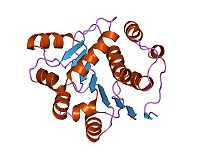
Photo from wikipedia
Structured RNAs and RNA-protein complexes (RNPs) fold through complex pathways that are replete with misfolded traps, and many RNAs and RNPs undergo extensive conformational changes during their functional cycles. These… Click to show full abstract
Structured RNAs and RNA-protein complexes (RNPs) fold through complex pathways that are replete with misfolded traps, and many RNAs and RNPs undergo extensive conformational changes during their functional cycles. These folding steps and conformational transitions are frequently promoted by RNA chaperone proteins, notably by superfamily 2 (SF2) RNA helicase proteins. The two largest families of SF2 helicases, DEAD-box and DEAH-box proteins, share evolutionarily conserved helicase cores, but unwind RNA helices through distinct mechanisms. Recent studies have advanced our understanding of how their distinct mechanisms enable DEAD-box proteins to disrupt RNA base pairs on the surfaces of structured RNAs and RNPs, while some DEAH-box proteins are adept at disrupting base pairs in the interior of RNPs. Proteins from these families use these mechanisms to chaperone folding and promote rearrangements of structured RNAs and RNPs, including the spliceosome, and may use related mechanisms to maintain cellular messenger RNAs in unfolded or partially unfolded conformations.
Journal Title: Biochemical Society transactions
Year Published: 2017
Link to full text (if available)
Share on Social Media: Sign Up to like & get
recommendations!